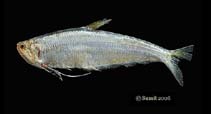| Family: |
Engraulidae (Anchovies), subfamily: Coiliinae |
| Max. size: |
40 cm TL (male/unsexed) |
| Environment: |
pelagic; freshwater; brackish, amphidromous |
| Distribution: |
Asia: Indian fresh and brackish waters (Ganges system, from Diamond Harbor on the Hooghly to as far up as Allahabad on the Ganges, perhaps further; also rivers and estuaries of Orissa). Reported from Bangladesh and Myanmar (Ref. 45255). |
| Diagnosis: |
Dorsal spines (total): 0-0; Anal spines: 0-0; Anal soft rays: 66-78. Belly with 21 or 22 keeled scutes from isthmus to anus. Lower gill rakers with the serrae even or becoming clumped in some specimens. Pectoral filament long, reaching to base of 15th to 39th anal fin ray. Anal fin with upper caudal lobe truncated, shorter than lower. Pectoral fins hyaline, but dark in fishes over 13.6 cm SL. |
| Biology: |
A riverine species, but also found in estuaries and presumably tolerating some salinity. Adults feed mainly on mysids and small prawns (reduced feeding during breeding), juveniles mainly on copepods. Possibly breeds throughout the year, with peaks in October and November (Hooghly at Barrackpore) or March-May (Ganges at Allahabad). Its large size makes it an attractive foodfish. |
| IUCN Red List Status: |
Least Concern (LC); Date assessed: 04 December 2019 Ref. (130435)
|
| Threat to humans: |
harmless |
Source and more info: www.fishbase.org. For personal, classroom, and other internal use only. Not for publication.

